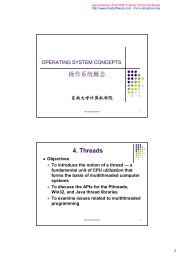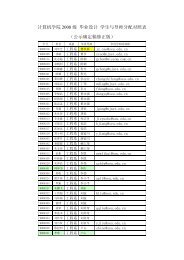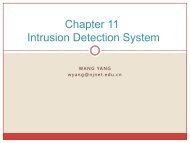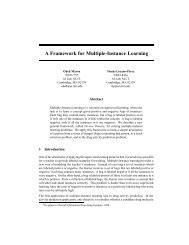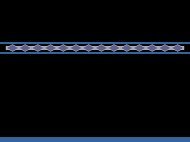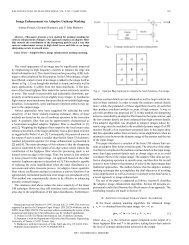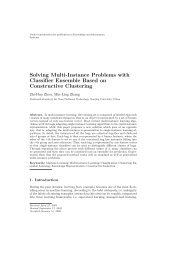You also want an ePaper? Increase the reach of your titles
YUMPU automatically turns print PDFs into web optimized ePapers that Google loves.
Lab6 Array I<strong>Objectivities</strong>1. Using rand to generate random numbers and using srand to seed the random-numbergenerator.2. Declaring, initializing and referencing arrays.3. The follow-up questions and activities also will give you practice:4. Remembering that arrays begin with subscript 0 and recognizing off-by-one errors.5. Preventing array out-of-bounds errors.6. Using two-dimensional arrays.<strong>Experiment</strong> 1Description of the ProblemWrite a program that simulates the rolling of two dice. The program should call rand to rollthe first die, and should call rand again to roll the second die. The sum of the two values shouldthen be calculated. [Note: Each die has an integer value from 1 to 6, so the sum of the two valueswill vary from 2 to 12, with 7 being the most frequent sum and 2 and 12 being the least frequentsums.] Figure L 7.1 shows the 36 possible combinations of the two dice. Your program should rollthe two dice 36,000 times. Use a one-dimensional array to tally the numbers of times each sumappears. Print the results in a tabular format. Also, determine if the totals are reasonable (i.e., thereare six ways to roll a 7, so approximately one sixth of all the rolls should be 7).Problem-Solving Tips1. Remember that array subscripts always begin with zero. This is also true for each dimension ofa multiple-subscripted array (which this lab does not use).2. The actual percentage is the likelihood, based on the results of your program, that a dice rollproduced a certain result. In other words, if you roll the dice 36,000 times the actual percentagewill be the (number of times a result occurred / 36000) * 100.
3. The expected percentage is the statistical probability that a dice roll will produce a certain result.This can be calculated from the diagram “36 possible outcomes of rolling two dice,” shown in theproblem description. For example, there is only one combination that will produce the sum of 2and there are 36 total combinations. Therefore, the expected percentage of rolling a 2 is 1/36 or2.778%.Follow-Up Questions and Activities1. What happens if the elements of array sum are not initialized to zero? Try to run the programwithout initializing the array. Show your results.2. Modify the program to use a two-dimensional array similar to the diagram in Figure L 7.1. Now,rather than counting the number of times each sum appears, increment the correct cell in the array.Print this array with the number of times each dice combination occurred. A sample output maylook like the following:****************<strong>Experiment</strong> 2The following program in this section does not run properly. Fix all the compilation errors sothat the program will compile successfully. Once the program compiles, compare the output withthe sample output, and eliminate any logic errors that may exist. The sample output demonstrateswhat the program’s output should be once the program’s code has been corrected.#include using std::cout;using std::endl;#include using std::setw;#include const int NUM_GRADES = 10;const int NUM_SUDENTS = 3;int findHighest( int );int findLowest( int * );void printDatabase( const int [][], const char [][ 20 ] );int main(){int student1[ NUM_GRADES ] = { 0 };int student2[ NUM_GRADES ] = { 76, 89, 81, 42, 66, 93, 104, 91, 71, 85, 105 };
int student3[ NUM_GRADES ] = { 65, 69, 91, 89, 82, 93, 72, 76, 79, 99 };char names[ NUM_SUDENTS ][ 20 ] = { "Bob", "John", "Joe" };int database[ NUM_SUDENTS ][ NUM_GRADES ];int i = 0;srand( time( 0 ) );// initialize student1for ( i = 0; i < NUM_GRADES; i++ )student1[ NUM_GRADES ] = rand() % 50 + 50;// initialize databasefor ( i = 1; i < NUM_GRADES; i++ ) {database[ 0 ][ i ] = student1[ i ];database[ 1 ][ i ] = student2[ i ];database[ 2 ][ i ] = student3[ i ];} // end forprintDatabase( database, studentNames );for ( i = 0; i < NUM_SUDENTS; i++ ) {cout
eturn lowest;// end lowestGrade// output datavoid printDatabase( int a[][ NUM_GRADES ], char names[][ 20 ] )cout
Lab7 Array IIObjectivesThis lab was designed to reinforce programming concepts from Chapter 7 of C++ How ToProgram: Sixth Edi-tion. In this lab, you will practice:• Sorting data using the bubble sort algorithm.The follow-up question and activity also will give you practice:• Optimizing a program to be more efficient.<strong>Experiment</strong>sIn the bubble sort algorithm, smaller values gradually “bubble” their way upward to the top of thearray like air bubbles rising in water, while the larger values sink to the bottom. The bubble sortmakes several passes through the array. On each pass, successive pairs of elements are compared.If a pair is in increasing order (or the values are identical), we leave the values as they are. If a pairis in decreasing order, their values are swapped in the array.Write a program that sorts an array of 10 integers using bubble sort.Data items in original order2 6 4 8 10 12 89 68 45 37Data items in ascending order2 4 6 8 10 12 37 45 68 89Template// Lab 2: bubblesort.cpp// This program sorts an array's values into ascending order.#include using std::cout;using std::endl;#include using std::setw;int main(){const int arraySize = 10; // size of array aint a[ arraySize ] = { 2, 6, 4, 8, 10, 12, 89, 68, 45, 37 };int hold; // temporary location used to swap array elementscout
{// loop to control number of comparisons per pass/* Write a for header to iterate j from 0 and keep looping while j is less than arraySize - 1 */{// compare side-by-side elements and swap them if// first element is greater than second element/* Write an if statement to test if element j is greater than element j + 1 */{/* Write code to swap the values in element j and element j + 1, using hold as temporarystorage */} // end if} // end for} // end forcout
check at the end of each pass if any swaps have been made. If none havebeen made, then the data must already be in the proper order, so theprogram should terminate. If swaps have been made, then at least one morepass is needed.Program ChallengeA prime integer is any integer greater than 1 that is evenly divisible only by itself and1. The Sieve of Eratosthenes is a method of finding prime numbers. It operates asfollows:1. Create an array with all elements initialized to 1 (true). Array elements withprime subscripts will remain. All other array elements will eventually be setto zero. You will ignore elements 0 and 1 in this exercise.2. Starting with array subscript 2, every time an array element is found whosevalue is 1, iterate through the remainder of the array and set to zero everyelement whose subscript is a multiple of the subscript for the element withvalue 1. For array subscript 2, all elements beyond 2 in the array that aremultiples of 2 will be set to zero (subscripts 4, 6, 8, 10, etc.); for arraysubscript 3, all elements beyond 3 in the array that are multiples of 3 will beset to zero (subscripts 6, 9, 12, 15, etc.); and so on.When this process is complete, the array elements that are still set to one indicate thatthe subscript is a prime number. These subscripts can then be printed. Write a programthat uses an array of 1000 elements to determine and print the prime numbers between2 and 999. Ignore elements 0 and 1 of the array.



